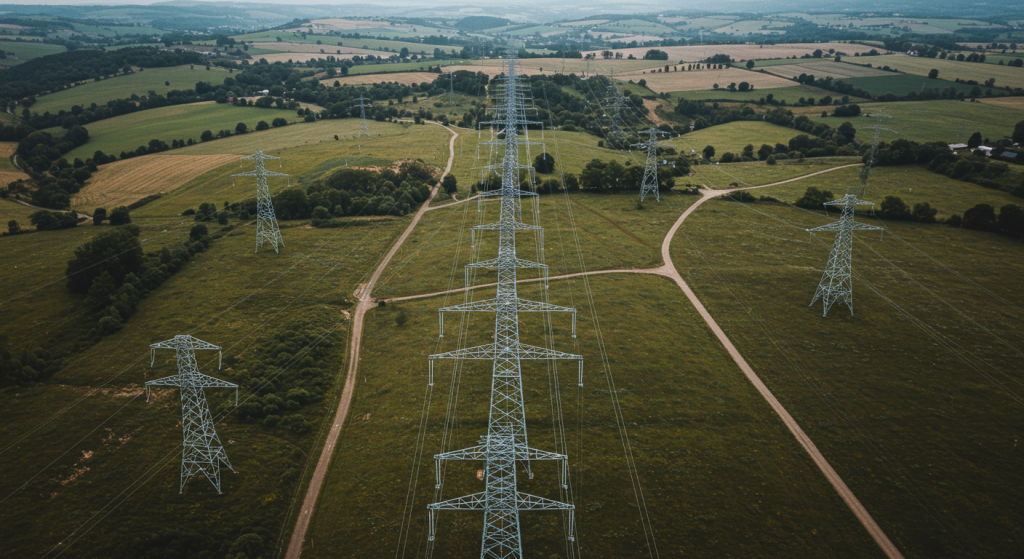Explore the Transmission Line Towers: An In-Depth Look
2025-04-18
What are Transmission Line Towers?
- Transmission line towers cross through the length of countries, states, as well as districts encompassing huge distances, whereby power is transported from generators till it reaches consumption elements like industries, towns, and homes. They stand as monument objects for electric power lines forming a bridge on the top section and forming the basis on the downside of towers, separating two areas with different heights.
- Towers have supports made of metals such as iron or steel. Additionally, the Triangle form used in cross sections increases the strength of all components of the tower without increasing the weight of the structure, which effectively treats cross girders. Furthermore, all equipment used for hanging wires and electric sockets is installed on these supports formed into the shape of pyramids.
Understanding Transmission Line Towers: Backbone of Power Distribution Systems
The parts of the grid and their interconnections constitute the basic framework of the power system, as a dynamic every ever-increasing load is distributed over geographically scattered network resources. Their importance has increased significantly in the development of any country since a power grid serves as a forming the foundation for modernization. Transmission line towers are critical parts within the nation’s power grid infrastructure as they facilitate the distribution of electricity at high voltage, and can be categorized under backbone parallels.
- Transmission Line Services: Reliable and Prompt Power Delivery
Our experts take care and ensure purposeful precision while servicing transmission lines by undertaking their design, construction, maintenance, and upgrades. All these services are imperative in guaranteeing that power is delivered safely and seamlessly to homes, businesses, and services through high-voltage power lines. We provide the entire spectrum of transmission line services with a focus on efficiency, safety, and minimum downtime.
- Design and Construction Tailored to Your Needs
As part of our Transmission line services, we undertake all levels of construction and design bespoke for your business. Our company provides optimal performance by using top-of-the-line technology and premium materials while constructing new transmission lines and improving the old infrastructure. Bei g a top-tier service provider, we make sure the execution of the design is safe, complies with regulatory standards, and meets customer criteria. We give customers different options from 10kV to 220kV of voltage grades.
- Proactive Approach to Power Continuity
Engineering something meticulously to perfection isn’t enough. Power flow is important and staff need to ensure its continuous flow. Transmission Line Services require a systematized maintenance mode by offering power reliability and flow assurances. With seamless power maintenance models by our overhauls, all recurring inspections, scheduled maintenance, and site repairs are done to keep operating technologies at maximum efficiency. These techniques, coupled with defect elimination strategies, guarantee uninterrupted power delivery to consumers.
- Advanced Materials and Customization
In regard to pylon structures and the materials of which they are made, we ensure maximum reliability through employing high-standard materials, including Q255B/Q355B/Q420B steel for the girders. We offer a wide range of pole heights from 5 meters to 200 meters, while the poles can endure up to 30M/S wind pressures. Each pole is treated with hot-dip galvanization, which increases its resistance to corrosion, thereby enhancing durability.
- Efficient and Safe Power Delivery
Our solutions guarantee that delivery of power to the customer is efficient and free from any unusual loss, while giving surety to its stabilization on an on-demand basis. The synergy between material selection, design optimization, and construction helps us greatly reduce maintenance work, increase infrastructure lifespan, and lower operational expenses. Reliability, performance, and a customer-friendly approach are made possible by employing sophisticated tools coupled with high-standard materials and exquisite craftsmanship.

Earthing Systems and Foundations: Other Supporting Structures
Earth towers supporting transmission lines must have sturdy foundations that can withstand their weight as well as external forces. Concrete is usually used in making the tower’s foundation, while the anchorage must keep the tower securely bolted within the earth. Moreover, earthing systems guarantee that all electrical faults are directed safely into the ground.
1. Territory Verification Survey
In addition to providing essential information for construction planning, the environmental site survey identifies the most optimal place for tower placement as well as power line routes, taking into account ecosystem factors, land usage, and nearby infrastructure.
2. Design Alternatives
Concerning the specific site location, the next step is choosing tower designs. This includes selecting the most accurate type of tower considering terrain features, expected operational loads, and local licensing agreements. Principles of transmission systems design are important to guarantee safety, reliability, and economy of use.
3. Product Construction
Then, the design is accepted, and we start the construction of the towers. This is usually the steel work of the lattice structure or tubular steel transmission poles. The components are fabricated off-site and delivered to the site for assembly.
4. Tower Erection and Line Installation
This is the last stage, which includes the elevation of the towers as well as the transportation devices- the transmission lines. This part of the construction is the most arduous, as each piece needs to be accurately aligned in its predetermined place at the required elevation within the range of the precision industrial robot’s radius.
Inspection and Maintenance of Transmission Line Towers
- In order to ensure transmission towers are maintained in a safe operating condition, periodic inspection and maintenance of the towers are required. This involves looking for signs of wear, corrosion, and wind, ice, or lightning damage.
- During routine maintenance of the tower, cleaning of the insulators, partial or complete replacement of derelict features, and dynamic essential structures substation to meet changing environmental conditions might be done. Repairing transmission lines, especially primary ones, is effectively done to minimize downtime and ensure high reliability of the power supply.
Guidelines and Safety Precautions
Safety precautions concerning electrical dangers to the public and construction workers are complied with. There are also policies to protect and promote health regarding the building and upkeep of transmission line towers. These include conditions on ice and wind stress, osmotic factors, and seismic zone limitations.
Conclusion
The power grid would suffer serious disruptions if transmission line towers were removed because they enhance the safety and reliability of the electricity supply across large distances. Gaining knowledge about the different types of towers, their parts, maintenance practices, and functions allows one to truly appreciate the important role they play in power delivery. Visit XY Tower if you are looking for expert guidance on the maintenance of power line towers or need reliable transmission tower manufacturers.

Привет, я Чуньцзянь Шу
"X.Y. Tower: Надежные, инновационные решения для высококачественных башен и электрооборудования с профессиональным сервисным обслуживанием.
